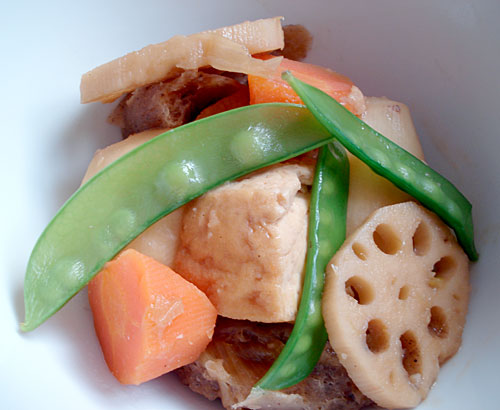
(On the forum and elsewhere, I frequently hear vegans lamenting the lack of vegan protein-rich dishes. Such dishes do exist in traditional Japanese cooking, and I try to introduce them to you. Not all dishes are that simple to make, though if you read through the recipes they aren't really that hard. Anyway, here's one vegan one-pot dish that is good hot or cold, so is very suited to bentos.)
There are all kinds of stewed dishes in Japanese cooking, called something-ni (煮). Collectively these are called 煮物 - ninomo. This is sort of a vegan variation on a classic nimono called chikuzen-ni (筑前煮), which is a staple of the New Year period and the winter months.
Chikuzen-ni gets its umami from chicken pieces and a rich dashi made from konbu seaweed and lots of katsuobushi, dried bonito flakes. Here I've skipped the dashi (though you could use vegan dashi for even more flavor), but I've used one of my favorite vegan proteins, atsuage or thick fried tofu, and added a lot of umami by using shiitake mushrooms, leek, and miso to finish. There are three kinds of root vegetables in this: taro root (satoimo 里芋 in Japanese), lotus root (renkon 蓮根)and carrots, so it's full of fiber and nutrition and is a fairly complete vegan meal. I used it for a bento last week, and found it very filling. (I meant to use the leftovers for another bento round at least, but it got eaten up by someone...)
If you can't get a hold of taro roots or dislike the slightly slimy texture, substitute boiling potatoes (the kind you use for potato salad, not baking potatoes). If you can't get lotus roots, just leave them out and use more carrots.
This is not a quick recipe, but you can make a potful of it and can last you for several days of bentos and other meals.